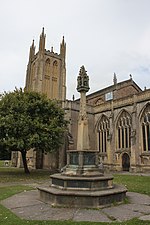Wells (Priory Road) railway station

Wells (Priory Road) was a railway station on the Somerset and Dorset Joint Railway at Wells in the county of Somerset in England. Opening on 15 March 1859 as Wells, on the Somerset Central Railway, at that time a broad-gauge line operated by the Bristol and Exeter Railway, prior to that company's amalgamation with the Dorset Central Railway to form the Somerset & Dorset, it was the terminus of the branch from Glastonbury. The East Somerset Railway, an offshoot of the Great Western Railway-owned Wilts, Somerset and Weymouth Railway, extended its line to Wells in 1862 with its own station to the east of Priory Road. Then in 1870, the Bristol and Exeter Railway's Cheddar Valley Railway from Yatton reached Wells with a third terminus station at Tucker Street to the north west of Priory Road. Finally, in 1878, with all three lines by this time converted to standard gauge, the GWR linked the Cheddar Valley line to the East Somerset line by running over a stretch of the Somerset and Dorset line, including through Priory Road station. The East Somerset station closed on the commencement of through-running, but the through trains did not stop at Priory Road until 1934 and for 56 years passengers from, say, Glastonbury to Cheddar would need to change stations in Wells. Priory Road adopted the full name in October 1883, and the Cheddar Valley line station was renamed as Tucker Street in 1920. Priory Road station consisted of one platform with a station building and an overall roof. The adjacent goods yard and junction with the GWR were controlled from a signal box. The station closed to passengers on 29 October 1951 and the train shed roof was taken down soon after, although passenger traffic on the former GWR line through the station continued until 1963, with goods traffic until 1969. The station was demolished after closure and the site is now occupied by the city centre by-pass road.
Excerpt from the Wikipedia article Wells (Priory Road) railway station (License: CC BY-SA 3.0, Authors, Images).Wells (Priory Road) railway station
Strawberry Way, Wells
Geographical coordinates (GPS) Address External links Nearby Places Show on map
Geographical coordinates (GPS)
| Latitude | Longitude |
|---|---|
| N 51.204161 ° | E -2.65301 ° |
Address
Wells (Priory Road)
Strawberry Way
BA5 2AU Wells
England, United Kingdom
Open on Google Maps







